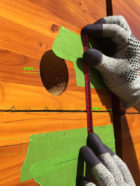"Campus of the Digital Age": Cornell Tech Officially Debuts on Roosevelt Island in New York
Moon Village
01/



After using machine learning to more quickly assess structural damages in Mexico City following its 2017 earthquake, SOM engineers have applied the new technology to other aspects of construction.
Timber construction is part of the holistic sustainable design strategy for Billie Jean King Library in Long Beach, California; the use of laminated timber structural beams dramatically reduces the building’s carbon impact. During construction, separations — known as “checking” — were spotted between some of the glued timber beams. Checking can occur naturally when wood separates as it settles into its new environment, but SOM’s engineering team wanted a closer look at some of the more significant separations.
Dozens of images of the girders were taken and then used to train a machine learning model to recognize the separations via object detection. An investigation determined that the more significant separations were partly because of abnormal fabrication methods on top of temperature and humidity differences experienced from fabrication site to installation site. New glulam girders were then put in where needed.

As a result of this successful outcome, SOM was then asked to help devise a Glulam Monitoring System (GMS), which would observe selected glulam girders for check formation and growth. Four locations (two with some checking and two without) were selected to be monitored for one year — enough time for the wood members to settle into their new environment — with a DSLR camera programmed to take one photograph a day. The camera was put into an SOM-designed plywood camera box system seamlessly integrated into the site and fit securely between parallel joists.
Those approximately 1,000 images were then uploaded to a platform to analyze the images for the amount and size of the checks spotted. After looking at the GMS’s findings, it was confirmed that no further intervention would be necessary.
With the growing use of timber construction in recent years, inspections were typically manual and could lead to varying data if different inspectors with different techniques were used as well as more limited data with post-construction sites limited to, typically, once a month. Machine learning, however, provides both engineers and clients more consistent and voluminous data to analyze as they observe glulam checking over time.
01/